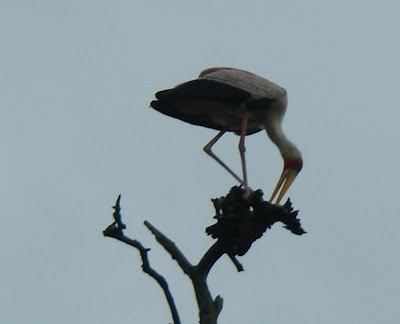 Our favourite town centre hang-outs, the French Cultural Centre - nice restaurant, a bit of peace and greenery and great cultural events.
Our favourite town centre hang-outs, the French Cultural Centre - nice restaurant, a bit of peace and greenery and great cultural events.Wednesday, December 24, 2008
Choice views of the Cap Vert Peninsula and Dakar
 Our favourite town centre hang-outs, the French Cultural Centre - nice restaurant, a bit of peace and greenery and great cultural events.
Our favourite town centre hang-outs, the French Cultural Centre - nice restaurant, a bit of peace and greenery and great cultural events.Tuesday, December 23, 2008
End of year 2008
We love tropical Christmas....quiet, warm and sunny. And we love the local Santa at the grocery store: a tall African man in a red Santa outfit.
 This end of year finds us well and with a good likelihood of staying in Dakar for a while longer. Update of the last couple of months:
This end of year finds us well and with a good likelihood of staying in Dakar for a while longer. Update of the last couple of months:
Gina just started a permanent half time job as the manager of the Club Atlantique with 8 Senegalese staff. It's a sports and activity family club where we have been using the 25m pool. There are also tennis and handball courts, a great children's playground, a Lebanese snack restaurant, a club house with a bar, books, TV, games, DVD lending library, etc.. All in all it's about supervising the running of a small business as an NGO. Patrons are largely expat families of many countries. Until February she is also doing her 2 nights/week of English EFL teaching.
Bernard finished his second Catholic Relief Services contract and is waiting to hear back from a few local/regional job applications. Thanks to his sister Tiphaine (our neighbour across the street who is also applying for jobs to keep her in Dakar) he is now doing a 25 day technical micro-finance Fr/En translation for the World Bank (oh, can the French be wordy about nothing! My CRS Anglophone colleagues liked my translated French best as I can write reasonable French but at least in an English get-to-the-point manner).
Tiphaine and Bernard took a scuba diving course and after all the hard work (lugging heavy gear and preparing for all unpleasant contingencies) we finally got to blow our own bubbles "inside the aquarium", among the underwater rocks of a marine reserve. So many fish and other critters with wonderful shapes, colors and behaviours. Fortunately, fish are mostly curious creatures, so it's great to just hover over rocks and look at the live show in 3D. (Sorry no underwater photos, my camera does not go that deep).
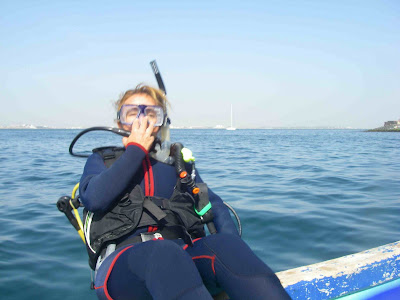 It is also the season for migratory birds and it's great to see them around. Bird watching is fun, part of it is the just the environment (quiet and reasonably natural) and the feel of discovery.
It is also the season for migratory birds and it's great to see them around. Bird watching is fun, part of it is the just the environment (quiet and reasonably natural) and the feel of discovery.
Our other sister Françoise came out to see us from Virginia for a week, which allowed her to decompress and enjoy the tropics and allowed us to do some touristy fun stuff (usually to do with beach, islands, swimming and good food).

 Bernard also went with some guys on a moto excursion, up the coast on the beach at low tide (oh, so smooth and quiet) and back on mostly dusty and bumpy but occasionally swampy or sandy tracks.
Bernard also went with some guys on a moto excursion, up the coast on the beach at low tide (oh, so smooth and quiet) and back on mostly dusty and bumpy but occasionally swampy or sandy tracks.


That's all for now and we wish you all a Very Merry Christmas and a Very Happy New Year, full of health and happiness.
Bernard, Gina and the ZZs.

 This end of year finds us well and with a good likelihood of staying in Dakar for a while longer. Update of the last couple of months:
This end of year finds us well and with a good likelihood of staying in Dakar for a while longer. Update of the last couple of months:Gina just started a permanent half time job as the manager of the Club Atlantique with 8 Senegalese staff. It's a sports and activity family club where we have been using the 25m pool. There are also tennis and handball courts, a great children's playground, a Lebanese snack restaurant, a club house with a bar, books, TV, games, DVD lending library, etc.. All in all it's about supervising the running of a small business as an NGO. Patrons are largely expat families of many countries. Until February she is also doing her 2 nights/week of English EFL teaching.
Bernard finished his second Catholic Relief Services contract and is waiting to hear back from a few local/regional job applications. Thanks to his sister Tiphaine (our neighbour across the street who is also applying for jobs to keep her in Dakar) he is now doing a 25 day technical micro-finance Fr/En translation for the World Bank (oh, can the French be wordy about nothing! My CRS Anglophone colleagues liked my translated French best as I can write reasonable French but at least in an English get-to-the-point manner).
Tiphaine and Bernard took a scuba diving course and after all the hard work (lugging heavy gear and preparing for all unpleasant contingencies) we finally got to blow our own bubbles "inside the aquarium", among the underwater rocks of a marine reserve. So many fish and other critters with wonderful shapes, colors and behaviours. Fortunately, fish are mostly curious creatures, so it's great to just hover over rocks and look at the live show in 3D. (Sorry no underwater photos, my camera does not go that deep).
 It is also the season for migratory birds and it's great to see them around. Bird watching is fun, part of it is the just the environment (quiet and reasonably natural) and the feel of discovery.
It is also the season for migratory birds and it's great to see them around. Bird watching is fun, part of it is the just the environment (quiet and reasonably natural) and the feel of discovery. Our other sister Françoise came out to see us from Virginia for a week, which allowed her to decompress and enjoy the tropics and allowed us to do some touristy fun stuff (usually to do with beach, islands, swimming and good food).

 Bernard also went with some guys on a moto excursion, up the coast on the beach at low tide (oh, so smooth and quiet) and back on mostly dusty and bumpy but occasionally swampy or sandy tracks.
Bernard also went with some guys on a moto excursion, up the coast on the beach at low tide (oh, so smooth and quiet) and back on mostly dusty and bumpy but occasionally swampy or sandy tracks.That's all for now and we wish you all a Very Merry Christmas and a Very Happy New Year, full of health and happiness.
Bernard, Gina and the ZZs.

Sunday, November 2, 2008
Trip to Casamance
I spent 10 days in Casamance, Southern Senegal for work, researching about rice production, and it was difficult to be in work mode rather than holiday mode. Firstly I got there on an overnight very modern ferry (of course I also spent a couple of hours with the engine technicians and on the bridge with the captain and pilot). Secondly I stayed in a wonderful waterfront hotel.
The place is tropical, green, full of beautiful birds and scenery, with many ecological and ethnic microcosms and very friendly people. I am ready to work and live there, it's clearly the best place in Senegal. Paradoxically, although it has the best agricultural potential of the country with abundant rain and water resources, it is also one of the poorest and very food insecure. Too long of an explanation for a blog, but it is full of potential.
So here are a few photos to try to convey the feel of the place:
 The French Cultural Centre, based on the local architecture and styles which included round compounds so that the circular roof would funnel water to the centre for a water source for people and animals.
The French Cultural Centre, based on the local architecture and styles which included round compounds so that the circular roof would funnel water to the centre for a water source for people and animals.
 Typical inland scenery with rice fields interspersed with clumps of trees.
Typical inland scenery with rice fields interspersed with clumps of trees.
 Sunset over Ziguinchor boats (pirogues)
Sunset over Ziguinchor boats (pirogues)
 Termite mound next to a crop of millet, very commonly grown in "upland" areas and which is a prime source of staple food, after rice.
Termite mound next to a crop of millet, very commonly grown in "upland" areas and which is a prime source of staple food, after rice.
 Typical view of the banks of the Casamance river from the ferry.
Typical view of the banks of the Casamance river from the ferry.

 There are many waterways called "bolongs", some are lined with mangroves and also with salt-resistant varieties of rice.
There are many waterways called "bolongs", some are lined with mangroves and also with salt-resistant varieties of rice.
 Atmospheric sunset
Atmospheric sunset
 Casamance premier beach resort place, called Cape Skiring, very mellow though.
Casamance premier beach resort place, called Cape Skiring, very mellow though.
 A bus owner everyones love: "I love my mother. The customer is king", if only it were true!
A bus owner everyones love: "I love my mother. The customer is king", if only it were true!
- - - - - - - - - - - - - - - - - - - -
And now for the bird life I could photograph with my quick and easy camera
The place is tropical, green, full of beautiful birds and scenery, with many ecological and ethnic microcosms and very friendly people. I am ready to work and live there, it's clearly the best place in Senegal. Paradoxically, although it has the best agricultural potential of the country with abundant rain and water resources, it is also one of the poorest and very food insecure. Too long of an explanation for a blog, but it is full of potential.
So here are a few photos to try to convey the feel of the place:
 The French Cultural Centre, based on the local architecture and styles which included round compounds so that the circular roof would funnel water to the centre for a water source for people and animals.
The French Cultural Centre, based on the local architecture and styles which included round compounds so that the circular roof would funnel water to the centre for a water source for people and animals. Typical inland scenery with rice fields interspersed with clumps of trees.
Typical inland scenery with rice fields interspersed with clumps of trees. Sunset over Ziguinchor boats (pirogues)
Sunset over Ziguinchor boats (pirogues) Termite mound next to a crop of millet, very commonly grown in "upland" areas and which is a prime source of staple food, after rice.
Termite mound next to a crop of millet, very commonly grown in "upland" areas and which is a prime source of staple food, after rice. Typical view of the banks of the Casamance river from the ferry.
Typical view of the banks of the Casamance river from the ferry.
 There are many waterways called "bolongs", some are lined with mangroves and also with salt-resistant varieties of rice.
There are many waterways called "bolongs", some are lined with mangroves and also with salt-resistant varieties of rice. Atmospheric sunset
Atmospheric sunset Casamance premier beach resort place, called Cape Skiring, very mellow though.
Casamance premier beach resort place, called Cape Skiring, very mellow though. A bus owner everyones love: "I love my mother. The customer is king", if only it were true!
A bus owner everyones love: "I love my mother. The customer is king", if only it were true!- - - - - - - - - - - - - - - - - - - -
And now for the bird life I could photograph with my quick and easy camera
Sunday, October 5, 2008
October 08 news from dakar
October Newsletter from Bernard and Gina from Dakar
Since July we've had an intense rainy season but it seems to be ending now, overall good for crops and livestock but bad for unprepared urban infrastructure with recurrent flooding and damage. Temperatures and humidity are up to the 30s and 80s and power and water cuts are frequent and long. We have now installed an “electricity robot” at home: a charger/inverter wired to a large car battery (basically like a large UPS for computers) so that we can enjoy the use of fans and laptops/internet/music for about 8 hours, regarlless of the SENELEC tantrums, and with whom we've had a clandestine hook up as their corrupt employees claim not to have electric meters to install (“but pay me something to not disconnect you”). For water we just fill up umpteen 10 liter water jugs stored in a spare room.
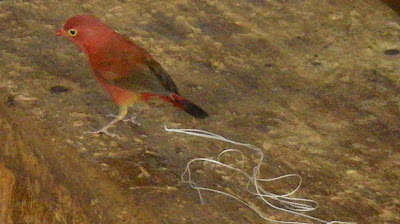
Bernard's first job with CRS finished at the end of July with the successful completion of the 3 year project to assist communities in Northern Senegal and Southern Mauritania hard hit by the locust plague of 2004 and to prepare the most vulnerable communities in Senegal against an outbreak of Avian Flu (there have been no cases in SN though there are large populations of migratory birds and neighboring countries have had outbreaks).
He was immediately recruited for a further 3 month consultancy by the CRS West Africa Regional Office as an itinerant rural development technical advisor to assist CRS country offices in francophone West Africa with developping new USAID funded projects to mitigate against the food price crisis. So far this has entailed assisting the offices in Senegal, Mali and Gambia (not francophone but logistically simple as it is surrounded by Senegal) to help poor farmers to improve their production of rainfed rice. The US Office for Foreign Disaster Assistance just requested more urgent proposals to assist those in most acute need in the 5 francophone west african sahelian countries (from Mauritania to Niger), thus another 12 day trip to Mopti, Mali, to research and pre-write a project to assist about 10,000 peri-urban squatters to re-locate and get access to more cropping land and develop more economic activities.
I have to say that, using generalities, Africa is poor because of its men but rich thanks to its women. Meetings with the women is always a serious but healthy laugh. Thus far, it's been more steep learning but with very competent and humorous colleagues. Scenery everywhere has been lush green with lots of millet growing, interspersed with groundnut (peanut), cowpea, maize and rice in swampy areas and herds of fat animals foraging. Bamako is surprisingly green and steamy, feeling more like Southeast Asia than the capital of Sahelian Mali, especially with the wide and overflowing Niger river (and its hippos).
Some work and travel impressions:
Farafenni, “upcountry” in the Gambia: very poor and not tourist friendly, no newspapers, AM/FM radio stations or Internet connection, only one guest house with mozzies and bedbugs and no idea what a “vegetable” is, plenty of grisstly meat bits but hard to find even bananas!
Visited the megalithic burial site of Wassu, dating from about AD 800, one of a few in this area.

The place is also full of wild birds, some very noisy!

Work involved distributing 50kg bags of urea fertiliser to 1,600 poor rice farmer women, sometimes in pouring rain. No men helped the women (sometimes older) to transport and lift the heavy bags. But they remained in good spirit and were appreciative of the gift to boost their own small rice production. Interestingly, rice cropping areas have severly decreased due to predation of hippos and warthogs (rice seedlings must taste like croissants to them).
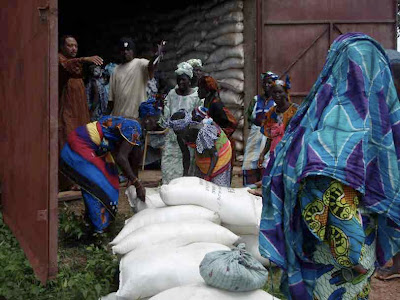 Also the whole of rice production is only women's work, from plowing, seeding, weeding, harvesting, storing, milling and cooking (no animal, no machine and no cash investment of any sort – seed, fertiliser, ploughing, treshing, etc.)! No wonder the yields are so low and harvesting can take a whole month. The main constraint is that the whole process is based on women managing their labour load (already substantial) and not on maximizing land or resource productivity, unlike most of Asia.
Also the whole of rice production is only women's work, from plowing, seeding, weeding, harvesting, storing, milling and cooking (no animal, no machine and no cash investment of any sort – seed, fertiliser, ploughing, treshing, etc.)! No wonder the yields are so low and harvesting can take a whole month. The main constraint is that the whole process is based on women managing their labour load (already substantial) and not on maximizing land or resource productivity, unlike most of Asia.
Casamance: I could have got there by Paris city bus: the “Paris-Barbes to Senegal-Casamance”. Hard to imagine how that bus got there!
 Also steamy, green and lush with many water “features” but of the muddy kind.
Also steamy, green and lush with many water “features” but of the muddy kind.

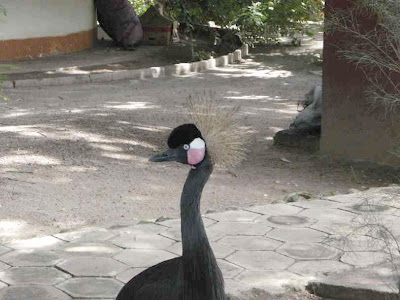 Local bird as a guest-house "pet"
Local bird as a guest-house "pet"
Check out this nice site for some of the Gambian (and Casamance) wildlife: http://ksossehgallery.blogspot.com/
Mopti in Mali: nice place in the rainy season and no tourists. It's on 3 large connected islands with the large river Niger dotted with small inhabited islands on one side and rice fields on the other.
The harbor is very busy with many crowded contraptions and is surrounded by thriving market stalls and boatbuilders (they hand make each nail!).
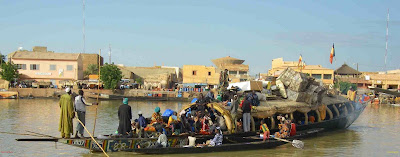
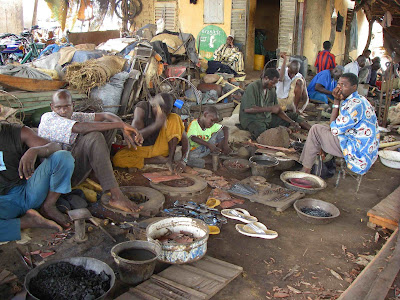
 You could reach Timbuktu, downriver, in 3 days by boat. I had a scurrying posse of colourful lizards around my feet at breakfast each morning, waiting to be fed corn flakes.
You could reach Timbuktu, downriver, in 3 days by boat. I had a scurrying posse of colourful lizards around my feet at breakfast each morning, waiting to be fed corn flakes.
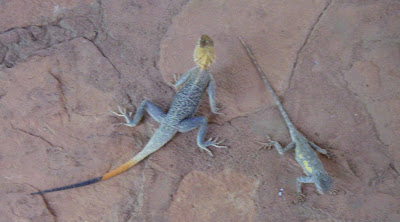
On the entertainment side, we have done a bit of sailing and continue swimming. Culturally, the rainy season is quiet as the expats go on holidays, it's hot and it's risky to hold any outdoor event but it's picking up again, we just saw some Senegal folk dancing, with a great drum band and an amazing African mask dancer on 6 foot giraffe skin decorated stilts – stunning. The kids shrieked and we almost did too.
Gina is about to start her next term of evening English classes for professionals and we now have a few potential end-of-year visitors.
The downside of living next to the unofficial “airport wildlife reserve” is that after each rain, despite our best efforts, we are invaded by all sorts of bugs and our window screens are artistically covered with “one use only” insect wings.
Best wishes to all for your autumn season while we head for dry and cooler weather. G&B&ZZs
Since July we've had an intense rainy season but it seems to be ending now, overall good for crops and livestock but bad for unprepared urban infrastructure with recurrent flooding and damage. Temperatures and humidity are up to the 30s and 80s and power and water cuts are frequent and long. We have now installed an “electricity robot” at home: a charger/inverter wired to a large car battery (basically like a large UPS for computers) so that we can enjoy the use of fans and laptops/internet/music for about 8 hours, regarlless of the SENELEC tantrums, and with whom we've had a clandestine hook up as their corrupt employees claim not to have electric meters to install (“but pay me something to not disconnect you”). For water we just fill up umpteen 10 liter water jugs stored in a spare room.

Bernard's first job with CRS finished at the end of July with the successful completion of the 3 year project to assist communities in Northern Senegal and Southern Mauritania hard hit by the locust plague of 2004 and to prepare the most vulnerable communities in Senegal against an outbreak of Avian Flu (there have been no cases in SN though there are large populations of migratory birds and neighboring countries have had outbreaks).
He was immediately recruited for a further 3 month consultancy by the CRS West Africa Regional Office as an itinerant rural development technical advisor to assist CRS country offices in francophone West Africa with developping new USAID funded projects to mitigate against the food price crisis. So far this has entailed assisting the offices in Senegal, Mali and Gambia (not francophone but logistically simple as it is surrounded by Senegal) to help poor farmers to improve their production of rainfed rice. The US Office for Foreign Disaster Assistance just requested more urgent proposals to assist those in most acute need in the 5 francophone west african sahelian countries (from Mauritania to Niger), thus another 12 day trip to Mopti, Mali, to research and pre-write a project to assist about 10,000 peri-urban squatters to re-locate and get access to more cropping land and develop more economic activities.
I have to say that, using generalities, Africa is poor because of its men but rich thanks to its women. Meetings with the women is always a serious but healthy laugh. Thus far, it's been more steep learning but with very competent and humorous colleagues. Scenery everywhere has been lush green with lots of millet growing, interspersed with groundnut (peanut), cowpea, maize and rice in swampy areas and herds of fat animals foraging. Bamako is surprisingly green and steamy, feeling more like Southeast Asia than the capital of Sahelian Mali, especially with the wide and overflowing Niger river (and its hippos).
Some work and travel impressions:
Farafenni, “upcountry” in the Gambia: very poor and not tourist friendly, no newspapers, AM/FM radio stations or Internet connection, only one guest house with mozzies and bedbugs and no idea what a “vegetable” is, plenty of grisstly meat bits but hard to find even bananas!
Visited the megalithic burial site of Wassu, dating from about AD 800, one of a few in this area.

The place is also full of wild birds, some very noisy!

Work involved distributing 50kg bags of urea fertiliser to 1,600 poor rice farmer women, sometimes in pouring rain. No men helped the women (sometimes older) to transport and lift the heavy bags. But they remained in good spirit and were appreciative of the gift to boost their own small rice production. Interestingly, rice cropping areas have severly decreased due to predation of hippos and warthogs (rice seedlings must taste like croissants to them).
 Also the whole of rice production is only women's work, from plowing, seeding, weeding, harvesting, storing, milling and cooking (no animal, no machine and no cash investment of any sort – seed, fertiliser, ploughing, treshing, etc.)! No wonder the yields are so low and harvesting can take a whole month. The main constraint is that the whole process is based on women managing their labour load (already substantial) and not on maximizing land or resource productivity, unlike most of Asia.
Also the whole of rice production is only women's work, from plowing, seeding, weeding, harvesting, storing, milling and cooking (no animal, no machine and no cash investment of any sort – seed, fertiliser, ploughing, treshing, etc.)! No wonder the yields are so low and harvesting can take a whole month. The main constraint is that the whole process is based on women managing their labour load (already substantial) and not on maximizing land or resource productivity, unlike most of Asia.Casamance: I could have got there by Paris city bus: the “Paris-Barbes to Senegal-Casamance”. Hard to imagine how that bus got there!
 Also steamy, green and lush with many water “features” but of the muddy kind.
Also steamy, green and lush with many water “features” but of the muddy kind.
 Local bird as a guest-house "pet"
Local bird as a guest-house "pet"Check out this nice site for some of the Gambian (and Casamance) wildlife: http://ksossehgallery.blogspot.com/
The harbor is very busy with many crowded contraptions and is surrounded by thriving market stalls and boatbuilders (they hand make each nail!).


 You could reach Timbuktu, downriver, in 3 days by boat. I had a scurrying posse of colourful lizards around my feet at breakfast each morning, waiting to be fed corn flakes.
You could reach Timbuktu, downriver, in 3 days by boat. I had a scurrying posse of colourful lizards around my feet at breakfast each morning, waiting to be fed corn flakes. 
On the entertainment side, we have done a bit of sailing and continue swimming. Culturally, the rainy season is quiet as the expats go on holidays, it's hot and it's risky to hold any outdoor event but it's picking up again, we just saw some Senegal folk dancing, with a great drum band and an amazing African mask dancer on 6 foot giraffe skin decorated stilts – stunning. The kids shrieked and we almost did too.
Gina is about to start her next term of evening English classes for professionals and we now have a few potential end-of-year visitors.
The downside of living next to the unofficial “airport wildlife reserve” is that after each rain, despite our best efforts, we are invaded by all sorts of bugs and our window screens are artistically covered with “one use only” insect wings.
Best wishes to all for your autumn season while we head for dry and cooler weather. G&B&ZZs
Subscribe to:
Posts (Atom)




















